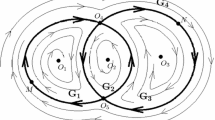Abstract
Computer simulations of dynamical systems arediscretizations, where the finite space of machine arithmetic replaces continuum state spaces. So any trajectory of a discretized dynamical system is eventually periodic. Consequently, the dynamics of such computations are essentially determined by the cycles of the discretized map. This paper examines the statistical properties of the event that two trajectories generate the same cycle. Under the assumption that the original system has a Sinai-Ruelle-Bowen invariant measure, the statistics of the computed mapping are shown to be very close to those generated by a class of random graphs. Theoretical properties of this model successfully predict the outcome of computational experiments with the implemented dynamical systems.
Similar content being viewed by others
References
P. M. Binder, Limit cycles in a quadratic discrete iteration,Physica D 57(1–2):31–38 (1992).
B. Bollobas,Random Graphs (Academic Press, London, 1985).
Y. D. Burtin, On a simple formula for random mappings and its applications,J. Appl. Prob. 17:403–414 (1980).
J. J. F. Cavanagh,Digital Computer Arithmetic. Design and Implementation (McGraw-Hill, New York, 1984).
P. Diamond, P. Kloeden, and A. Pokrovskii, An invariant masure arising in computer similar of a chaotic dynamical system,J. Nonlinear Sci.,4:59–68 (1994).
P. Diamond, P. Kloeden, and A. Pokrovskii, Analysis of an algorithm for computing invariant measures,Nonlinear Analysis TMA 24:323–336 (1994).
P. Diamond, P. Kloeden, and A. Pokrovskii Interval stochastic matrices and simulation of chaotic dynamics, inChaotic Numerics, P. Kloeden and K. J. Palmer, eds. (American Mathemtical Society, Providence, Rhode Island, 1994), pp. 203–216.
P. Diamond, P. Kloeden, A. Pokrovskii, and M. Suzuki, Collapsing effects in numerical simulation of chaotic dynamical systems, inProceedings of 94 Korea Automatic Control Conference. International Session (Taejon, Korea, 1994), pp. 753–757.
P. Diamond, P. Kloeden, A. Pokrovskii, and A. Vladimirov, Collapsing effects in numerical simulation of a class of chaotic dynamical systems and random mappings with a single attracting centre,Physica D 86:559–571 (1995).
G. A. Edgar,Measure, Topology and Fractal Geometry (Springer-Verlag, New York, 1990).
T. Erber, N. F. Darsow, M. J. Frank, and T. M. Rynne, The simulation of random processes on digital computers: Unavoidable order,J. Comput. Phys. 49:394–419 (1983).
T. Erber and D. Gavelek, The iterative evolution of complex systems,Physica A 177:394–400 (1991).
P. M. Gade and Chaitali Basu, The origin of non-chaotic behavior in identically driven systems, preprint from chao-dyn archive, Los Alamos (1995).
D. Gavelek and T. Erber, Shadowing and iterative interpolation for Čebyšev mixing transformations.J. Comput. Phys. 101:25–50 (1992).
I. B. Gerchbakh, Epidemic processes on a random graph: Some preliminary results,J. Appl. Prob. 14:427–438 (1977).
P. Grassberger and I. Procaccia, On the characterization of strange attractors.Phys. Rev. Lett. 50:346–349 (1983).
C. Grebogi, E. Ott, and J. A. Yorke, Roundoff-induced periodicity and the correlation dimension of chaotic attractors,Phys. Rev. A 34:3688–3692 (1988).
J. Guckenheimer and P. Holmes,Nonlinear Oscillations, Dynamical Systems and Bifurcations of Vector Fields (Springer-Verlag, New York, 1983).
M. V. Jakobson, Ergodic theory of one-dimensional mappings, inSovremennye Problemy Matematiki. Fundamentalnye Napravlenija, Vol. 2 (AN SSSR, VINITI, Moscow, 1982), pp. 204–232 [in Russian].
A. N. Kolmogorov and V. A. Uspenskii, Algorithms and randomness,Theory Prob. Appl. 32:389–412 (1987).
M. A. Krasnosel'skii and A. V. Pokrovskii,Systems with Hysteresis (Springer-Verlag, Berlin, 1989).
O. E. Lanfod, Some informal remarks on the orbit structure of discrete approximations to chaotic maps, unpublished (1995).
Y. E. Levy, Some remarks about computer studies of dynamical systems,Phys. Lett. 88A:1–3 (1982).
Y. E. Levy, Ergodic properties of the Lozi mappings,Commun. Math. Phys. 93:461–482 (1984).
M. Loève,Probability Theory (Van Nostrand, New York, 1963).
W. di Melo and S. van Strien,One-Dimensional Dynamics (Springer-Verlag, Berlin, 1993).
D. Ruelle,Elements of Differentiable Dynamics and Bifurcation Theory (Academic Press, Boston, 1989).
V. E. Stepanov, Random mappings with a single attracting centre,Theory Prob. Appl. 16:155–161 (1971).
Author information
Authors and Affiliations
Rights and permissions
About this article
Cite this article
Diamond, P., Klemm, A., Kloeden, P. et al. Basin of attraction of cycles of discretizations of dynamical systems with SRB invariant measures. J Stat Phys 84, 713–733 (1996). https://doi.org/10.1007/BF02179655
Received:
Issue Date:
DOI: https://doi.org/10.1007/BF02179655



